
We have now experienced 25 years of significant drought in the southwestern United States and northwestern Mexico. In the Colorado River basin (Figure 1), the annual flow of the Colorado River has decreased by approximately 19% in the 21st century compared to the 20th century.
From 1906 to 2000, the Colorado River basin averaged about 14.6 million acre-feet (MAF) annually. In the 21st century, average annual flows on the Colorado River have averaged approximately 12.5 MAF per year. This represents a decrease of about 1.75 MAF per year, which is approximately 19% less than the 20th-century average (https://www.congress.gov/crs-product/R45546).
This decline is attributed to the change in the climate with warming temperatures and reduced precipitation and is being referred to as a megadrought. The megadrought in the southwestern United States, beginning in 2000, is currently the driest multi-decade period in the region since at least 800 CE. This megadrought has been the driest in at least 1,200 years, exceeding a similar megadrought in the late 1500s. (Woodhouse, et al. 2010).
Long range climate models predict further reductions in Colorado River stream flows, with some projections showing declines of 5% to 30% compared to the 1971-2000 average by 2050 (Colorado Climate Center, 2023).
As a result, reservoirs are low throughout the region and the stress on water delivery systems is extreme. Recent projections by the U.S. Bureau of Reclamation indicate a high probability of water levels at Lake Mead in December 2026 to be lower than 1,050 ft. above sea level (Figure 2), which would trigger Tier 2a reductions based on the 2007 interim guidelines, Minute 323, lower basin drought contingency plan, and the binational water scarcity contingency plan (Figure 3).
However, all these conservation guidelines on the Colorado River will expire in 2026. Therefore, there is still the need for the delegations representing the Colorado River basin states to develop an agreement on a new set of conservation guidelines. At present, the lower basin states are in agreement, but the upper basin states will not accept the terms proposed by the lower basin states. Thus, they remain at an impasse.
Based on the Law of the River (The Law of the River: Foundational Documents and Programs, CRS, 2025), if the basin states are not able to decide on a new plan together, the U.S. Department of the Interior (DoI) and the Bureau of Reclamation (BoR) will have the responsibility for making the decisions.
At present, a new commissioner for the BoR has not been appointed by the new federal administration. However, based on my understanding from recent basin state meetings, the BoR has been more engaged under the Trump administration and that should be helpful. Stong leadership on these issues is urgently needed, and the situation is presenting a serious test on our system of governance on the Colorado River.
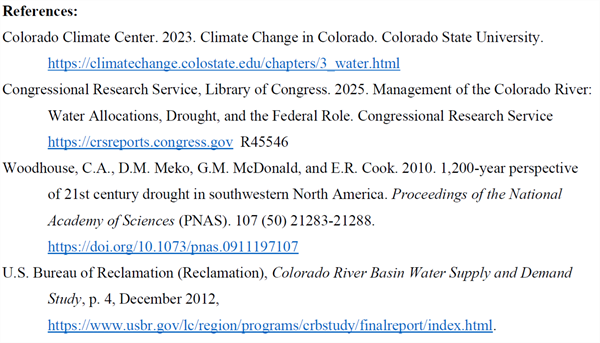
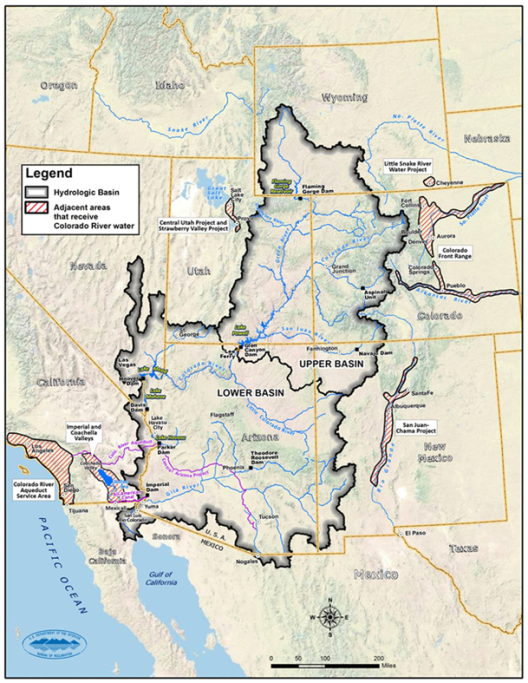
Figure 1. The Colorado River basin and U.S. areas that import Colorado River water.
Source: Bureau of Reclamation, Colorado River Basin Water Supply and Demand Study,
2012.
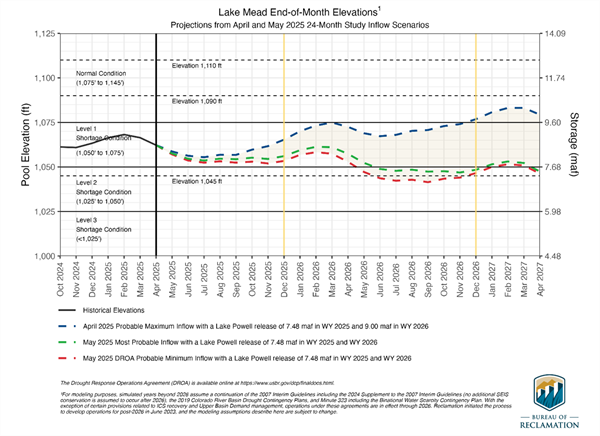
Figure 2. Lake Mead end-of-month elevations based on model projections from April and
May 2025, 24-Month study inflow scenarios.
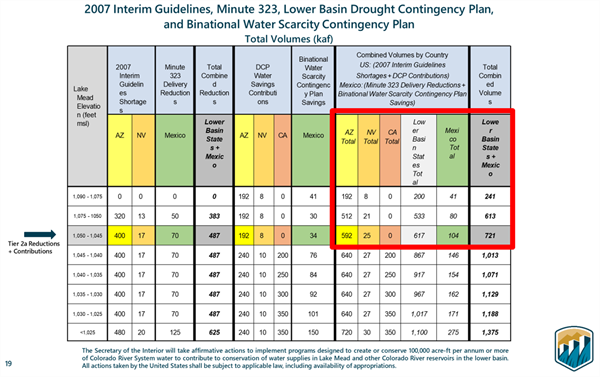
Figure 3. Tier 2a reductions based on the 2007 interim guidelines, Minute 323, lower
basin drought contingency plan, and binational water scarcity contingency plan.
Source: U.S. Bureau of Reclamation.
Dr. John Palumbo never sought the spotlight, but everything he did—every trial, field visit, and conversation—pointed us toward something better: better science, better decisions, better farming.
I’ve looked up to John since my undergraduate days. He was the model of what I hoped to become: a scientist grounded in integrity, driven by purpose, and deeply connected to the people and land he served. A career-long dream came true when I asked him to join my Ph.D. committee—and he said yes. A defining moment in my journey that I’ll always carry with me.
The work we hoped to do with him is now a reminder of how much he still had to offer. But more than anything, I’m grateful. Grateful that I got to learn from him, talk with him, and be challenged by him. I especially loved when I’d share an idea and he would provide feedback like, “Now I don’t like the sound of that, and I’ll tell you why...” To me that meant he was listening closely. He cared. He was genuine.
John didn’t just give us answers—he gave us perspective and the confidence to ask better questions. His perspective came from a place of hard-earned wisdom which he shared humbly and freely. We’ve lost a giant, but his impact remains in our work, our conversations, and the values he quietly instilled. His presence is deeply missed—and deeply lasting.We conducted a series of trials during Fall 2024 and Spring 2025 to evaluate the efficacy of organic-approved insecticides currently on the market. While some of the products evaluated were found to be effective, the results of our studies demonstrated that most of these marketed organic-approved insecticides had marginal to no efficacy against common insect pests that attack vegetable crops in the desert. When the insecticides were evaluated alone, the highest label rate was used; when assessed as a mixture of two products, each product was applied at half of the label rate.
Below, we list the insecticides that resulted in some level of suppression for each insect pest.
1- Brassica
Pale stripes flea beetle: Biolink (insect & bird repellent), Insect & Bird repellent mix with Pyganic, and Entrust mix with M-Pede can provide measurable suppression of pale stripe flea beetle. Multiple applications may be required to enhance seedling protection.
Whitefly: M-Pede performed best against whiteflies on brassicas, but Surround, Pyganic, and BotaniGard can also provide some marginal level of suppression. It is best to apply Surround and BotaniGard when the plants are small. Dense foliage prevents insecticide droplets from reaching the lower leaves, where most whiteflies are located on the plants.
Diamondback moth and Beet armyworms: XenTari, DiPel, Entrust, a tank mix of DiPel and Pyganic, or XenTari and Pyganic are the most effective options for controlling diamondback moth and beet armyworms. Starting with XenTari in a rotation program can lead to greater suppression of diamondback moths.
Green peach aphid: Aza-Direct can provide measurable (greater than 50% reduction) green peach aphid suppression on broccoli. Because Aza-Direct works as a growth regulator, it is recommended to apply it early in the season to allow the product sufficient time to work and enhance its efficacy.
2- Lettuce
Green peach aphid: Aza-Direct and M-Pede exhibited variable performance when applied to broccoli or lettuce. Aza-Direct performed better at controlling green peach aphid in broccoli, but M-Pede provided the greatest (>50% suppression) green peach aphid suppression in lettuce.
Thrips: Entrust can provide excellent (>90%) control of thrips nymphs and adults. In our studies, other bioinsecticides, such as Gargoil and Aza-Direct, also resulted in thrips suppression of approximately 40% and 50%, respectively. In a rotation program, Aza-Direct and/or Gargoil can be applied at the beginning of the season when thrips populations are low, and thrips injuries are less problematic.
Bioinsecticides and their active ingredients

Lettuce is one of the most important vegetable crops in the Yuma, Arizona region. However, growing healthy lettuce in the desert isn’t easy. High temperatures, salty soils, and very low rainfall (less than 3 inches per year) make crop management especially difficult. Growers are always looking for better tools to improve crop growth while saving water and reducing input costs.
Biostimulants are one such tool. These are natural products often made from seaweed extracts, organic acids, or beneficial microbes that are added to the soil or irrigation water. They don’t replace fertilizers, but they can help plants grow better by improving how roots absorb nutrients and handle stress like heat, drought, or poor soil quality.
Our Trial in Yuma, AZ
To better understand whether biostimulants can help desert lettuce crops, we conducted a field trial during the 2024–2025 growing season at the University of Arizona’s Valley
Research Center in Yuma. The field was managed using subsurface drip irrigation, a water-saving system that delivers moisture directly to the plant roots below the soil surface. We tested a commercially available biostimulant made from organic compounds and micronutrients known to support root and shoot growth.
The trial included several treatments, some with biostimulant and some without, under both traditional and sensor-based irrigation scheduling. We tracked plant height every two weeks to monitor lettuce growth and compared results between the treated and untreated plots.
What We Found
In the organic lettuce trial, biostimulant use did not result in a clear or measurable increase in plant height. All treatments (Figure 1), whether biostimulant was applied or not, showed similar growth patterns and reached comparable final heights by the end of the season. In the conventional lettuce trial, the tallest plants appeared in the biostimulant-treated plots; however, the difference compared to untreated plots was small and not statistically significant. When the data from both systems were combined, conventional treatments consistently produced taller plants than organic ones, regardless of biostimulant application. These findings suggest that biostimulant effects on plant height are minimal and highly dependent on the production system and environmental or management factors.
Takeaway
Biostimulants may not be a magic solution for crop growth and development, but they offer promise as part of an integrated crop management strategy. In desert systems where water is limited and soils can be harsh, even modest improvements in plant growth can help growers increase their productivity and resilience.
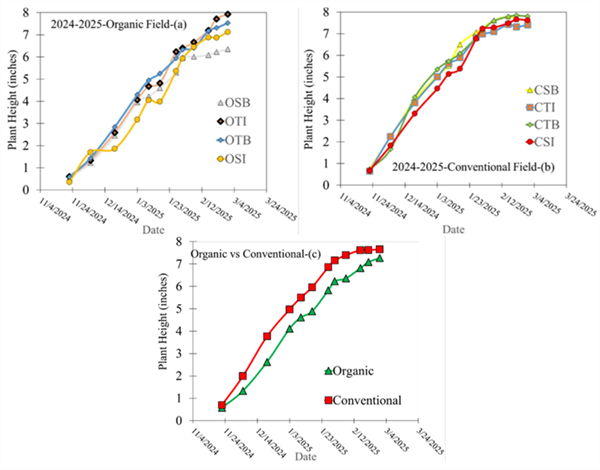
Figure 1. Distribution of plant height: (a) Organic Field; Organic sensor-based irrigation +
biostimulant (OSB), Organic traditional-based irrigation (OTI), Organic traditional-based
irrigation + biostimulant (OTB), and Organic sensor-based irrigation (OSI); (b)
Conventional Field; Conventional sensor-based irrigation + biostimulant (CSB),
Conventional traditional-based irrigation (CTI), Conventional traditional-based irrigation +
biostimulant (CTB), and Conventional sensor-based irrigation (CSI); (c) Pooled data for
Organic and Conventional Field treatments. Each data point represents the average of
10 readings collected in the field at the Valley Research Center, University of Arizona,
Yuma Agricultural Center, Yuma, Arizona.